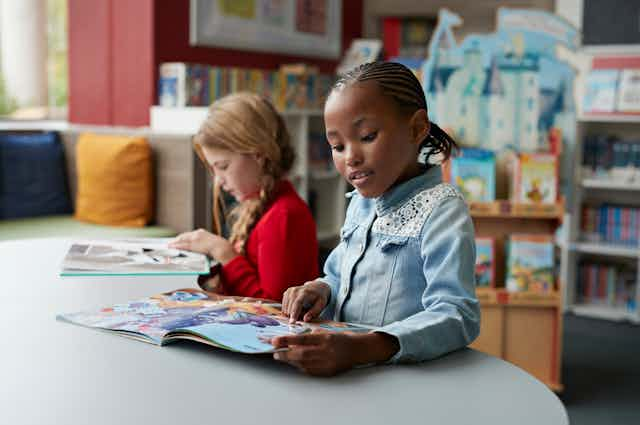Michelle Martin is the Beverly Cleary Professor for Children and Youth Services in the Information School at the University of Washington. She primarily teaches students who will be youth services librarians who work with children and young adults in libraries or other information science spaces. Below are highlights from an interview with The Conversation U.S. Answers have been edited for brevity and clarity.
How did you get to where you are today?
I have a doctorate in English, specializing in children’s and young adult literature. I spent the first half of my 25-year career in English departments, teaching education and English majors. And then I shifted to social science when I joined the University of South Carolina’s library school in 2011. Since 2016, I have taught future librarians at University of Washington in the Information School (which began as the Library School).
What would surprise someone about the work you do if they don’t know about what you study?
Some of my publications have more to do with children in books than with real children who read books. Those who study children’s literature from an English studies perspective look at children’s books as literary and artistic artifacts and attend to aspects like the art, character development and applying different theoretical readings to texts for young people rather than focusing on what children and young adults do with books. But I care deeply about children and how they interact with books, which is often more of a focus of those who teach children’s literature in library science and education departments. My teaching, research and service cross all three disciplines.
A lot of the work that I do now really helps adults understand the importance of exposing children to diverse perspectives in books and for children to be able to see their own experiences in the books that they read. The books that you grew up on might not necessarily be good for or the most entertaining to children you’re working with now.
I need to really do my homework and read widely to be able to teach and recommend books that represent kids’ life experiences and families who come from different backgrounds.
How has the role of libraries shifted as a result of the pandemic?
Libraries have been under a lot of the same stresses that everyone else has. But even though many libraries closed physically, they continued to serve their communities. Libraries have worked hard to to meet their communities where they are, especially those that have been hardest hit by the pandemic – from providing virtual storytimes to career assistance. For instance, many libraries extended their Wi-Fi into the parking lot so that parents could drive their kids to the library, download their homework and go home and do it. Even though many students had a laptop provided by the school, if they lived in rural areas where there’s no internet, they did not have what they needed to succeed in school. Libraries helped to support many of these families.
I’ve heard so many stories of ways libraries met the needs of the community during the pandemic, such as providing clothing or food or enhancing information access by offering no-contact, curbside pickup, or turning personal vehicles into a bookmobiles to deliver books to those who could not get to the library.
Some readers might think of libraries as institutions that don’t change. And maybe the pandemic has proved that libraries can adapt and change with the times as we need them to.
I’m working on a research project right now called Project VOICE that seeks to help libraries plan outreach with, not for, their communities with a social justice lens and with participatory design. We recommend that librarians work closely with the community and community partner organizations to discern what the community’s assets and values are and take a strengths-based approach to creating outreach programs rather than the deficit model that focuses on weaknesses and needs.
We’re encouraging libraries to depart from the approach that says, “Hey, we’re the library, here’s what we do well. Can you use it?” and instead ask, “As members of this community, you know best what the community’s values and assets are. How can we, as the library, partner with you to support your goals and aspirations?”
Because communities across the country are more diverse than ever, and becoming more so, it’s really important for librarians to spend time and effort building relationships with those in the community. This will ensure that libraries continue to understand the nuances of how to best serve their community, especially as the face of that community changes rapidly.

